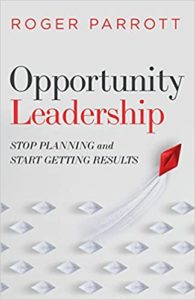Leaders are expected to have a vision for the future, articulated with measurable outcomes. But is that really the best way to lead?
‘Where do you expect the university to be in five or ten years?’
the best plan we could come up with around conference tables pales in comparison to the plan that God has in store for us
As the president of a university, this is a question I am asked regularly. That’s a very natural question to ask of any CEO because society expects leaders to have a ‘vision’ for the future. And we’ve been schooled to believe that we must lavishly articulate that vision in measurable outcomes.
When asked that question, my response is—and this is the absolute blunt answer which I’ve even shared in television news interviews—’I have no idea. But I do know that the best plan we could come up with around conference tables pales in comparison to the plan that God has in store for us.’
Candidly, I don’t know what our future as a university looks like. We may have more students five or ten years from now, or fewer students. I don’t know what new academic programs we might add or cut. I don’t know where we might open new campuses or close some. I don’t plan the future. Our destination is totally dependent on God bringing us opportunities. And so, not only do I not plan for the future, but even more importantly, I don’t worry about it.
Based on history and the shaping of cultural and market forces, I could easily speculate about what the future might hold, but I don’t plan for a specific future, nor do I work to hit specific growth targets. Having lived Opportunity Leadership for many years now, I know that when I look back to consider what I might have anticipated five or ten years ago, today’s reality will look nothing like the future I could have imagined at the time.

Opportunity Leadership is grounded in waiting in anticipation for God-given opportunities to develop that mesh seamlessly with our mission, gifting, and capacity—propelling us to destinations that are heavenly ordained. As a result, we become leaders who hone traits that enable us to become highly sensitive to the wind of God and create an organizational culture that allows us to respond to new opportunities with urgency, adeptness, and energy.
Opportunity Leadership is grounded in waiting in anticipation for God-given opportunities to develop that mesh seamlessly with our mission, gifting, and capacity
Instead of destination planning, what we must plan well is the execution of our implementation agenda. At my university, we teach history, hold chapel services, play football, provide food service, pay the bills, and complete all the other functions that go into running a small city on a campus. We plan and work hard to ensure those activities are robust, efficient, seamless, and effective. It is good stewardship to plan well what we know we are responsible for doing, and I believe God won’t entrust us with more if we don’t use well what we already hold in our portfolio.
This type of implementation planning must be developed as locally as possible, with the people in the trenches carrying out the specific work. In contrast, comprehensive visionary plans are often drawn up by boards, CEOs, and strategic task forces. Then those leaders spend the following months or years in frustration because the frontline implementers can’t move the changes forward with the same seamlessness envisioned by the planning team.
As leaders, we find our true calling when we break free from a traditional planning process anchored in structure, stability, and control. Instead, we focus on being attentive, informed, and flexible enough to capture opportunities.
The Negative Effects of Destination Planning
The church has learned to build organizations that often mirror the impressiveness of those constructed by the business world. But unlike secular institutions, our eternal focus values the quality of the journey, not simply establishing new beachheads. Structured destination planning not only limits what we might accomplish, but the nature of the process creates five by-products that pollute a ministry’s organizational culture.
![]() 1. Destination planning rarely produces the most significant outcomes in our ministry.
1. Destination planning rarely produces the most significant outcomes in our ministry.
Look back on the last decade of your ministry. What was the most significant outcome? Was it drawn out in a plan? Maybe a new building was planned, or one new initiative. But did you prepare for that key new employee who has made all the difference? Did you plan for the successes you most talk about with donors today? Did a new vital ministry area emerge because you planned it from scratch months or years in advance, or did unexpected opportunities open those doors?
Unless you are way outside the norm, what is significant is rarely envisioned through a formal planning structure. And if you answer that the planning structure did work and produced exactly what you expected, then I’d make the case you probably missed the best things God had for you because your powerboat was ignoring the wind of God when it blew in your direction.
![]() 2. Destination planning homogenizes your strengths and enables mediocrity.
2. Destination planning homogenizes your strengths and enables mediocrity.
In a traditional planning process, everyone must be included, but if you’re treating every gift of your ministry of equal value, you’re missing your God-given calling and gifts. At my university, God opened the opportunity for us to become a leader in the arts. In those early days of building our university, we woefully lacked in many key areas. Still, we were beginning to develop an exceptional dance program at a time when no other Christ-centered university offered a dance major. Capitalizing on that strength, we promoted it, funded it, staffed it, and built top-quality facilities for it.
If we had entrusted our future to the traditional strategic planning process, no stakeholder group would ever have promoted such lavish expenses for dance when we were woefully understaffed and underfunded in other important academic departments. But God wasn’t bringing us the opportunities in these other areas as He did in dance. His wind was blowing to create something dramatic for Christians in dance, and we captured the moment. And since that time, our dance program has brought national and international visibility to our campus. Focusing on the opportunity to build on this strength has ‘lifted all the boats’ as we’ve been able to grow the whole of the institution on the reputation of our dance department.

![]() 3. Destination planning primarily focuses on deficiencies.
3. Destination planning primarily focuses on deficiencies.
Yes, your planning structure will probably include a SWOT analysis that attempts to align your strengths. But planning by nature primarily focuses on what you don’t have rather than celebrating what you’ve been given.
Opportunity Leadership flips the table, setting your attention on the change that comes from God’s blowing wind, while also learning to be satisfied that other needs are being met for now as God intends. Planning that accentuates your shortcomings, rather than rejoicing in your blessings, is not creating a culture for expanded reach and growth—or building the ministry-wide thankful spirit that honors God. To replace deficiency-focused planning with opportunity-focused anticipation, the testimony of Paul in Philippians 4, first, we must avoid the trap that allows planning to become a structure for collective worry (v 6-7). And second, we must prevent planning from diminishing the value of the gifts God has already entrusted to our ministry (v 8, 12-13).
![]() 4. Destination planning delays decisions, creates tension, limits dialogue, and sets unrealistic expectations.
4. Destination planning delays decisions, creates tension, limits dialogue, and sets unrealistic expectations.
Traditional planning delays decisions to the point that the solutions are often partially irrelevant by the time they are settled. The protracted process most often adds to the tension because everything comes to a halt waiting for the planning group to finish their work. Discussion is limited because we seek to contain all dialogue within the cone of confidentiality required of the planning team.
Worst of all, it creates short-lived hope because imagined projections of the future can never live up to reality. I’ve built lots of buildings over the years, but I learned after the first half-dozen never to commission an architectural rendering of the building. Those drawings are very costly, but more importantly, they are even more costly to morale because no building could look as good as the perfectly drawn architect’s rendering.
![]() 5. Destination planning is somewhat silly in that it nearly always focuses attention on contrived numbers.
5. Destination planning is somewhat silly in that it nearly always focuses attention on contrived numbers.
Why would your goals be met in the year 2030, instead of 2029 or 2031? Why are our financial needs for a project nearly always set at $1 million, $5 million, or $10 million, or another even number, instead of a specific need? Why are our efforts for evangelistic reach always in round numbers that end with at least three zeros, as are our projections for the crowd invited to a major gathering?
Goals stated in bold round numbers are not a hallmark of planning—that’s marketing. It is okay for messaging, if that’s the easiest way to communicate the vision to your constituency. But don’t confuse bold round numbers with meaningful plans.
Goals stated in bold round numbers are not a hallmark of planning—that’s marketing. Don’t confuse bold round numbers with meaningful plans.
COVID-19 is the most straightforward example of why traditional planning is ineffective. Did your ministry plan for it? Did anyone? Of course not! But we all dealt with it, made adjustments rapidly, and even found ways to significantly improve our ‘normal ministry’—even though a simultaneous worldwide pandemic was not included in the five-year plan of a single ministry leader.
When the virus hit, every long-range organizational plan was tossed in the trash, and we all became stronger leaders because we couldn’t depend on a pre-determined plan to cope with this challenge. Instead, this ‘opportunity of crisis’ required us to provide leadership through it. And most importantly, we all became more dependent on God for the future rather than leaning on our carefully crafted plans.
For ministries, the jarring and speedy adjustments we made during COVID-19 were a forced push to step into the core of Opportunity Leadership. It’s a model of leadership that begins and ends with complete trust in God for a ministry’s direction. It allows future destinations to be ordered by His hand and loosens our iron grip on the wheel of control. When we embrace it, we join those leaders who have become free from the overwhelming burden of determining what is best for their ministry. We no longer need to manipulate our efforts and circumstances to engineer outcomes that force pre-determined destinations to be reached.
Editor’s Note: This is an edited excerpt from Roger Parrott’s book, Opportunity Leadership: Stop Planning and Start Getting Results (Moody Publishers, February 2022).
 Get ready to forget everything you know about ‘working your plan’. In this counterintuitive book, innovative university president Roger Parrott turns leadership on its head and shows you how unexpected opportunities–the ones you may be missing–are the key to your success. With an Opportunity Leadership mindset, you’ll see God-directed results like never before. In plain language, Dr Parrott guides you in developing six traits to focus your leadership outlook on untapped opportunities. Not only that, he provides a step-by-step plan for you to create six organization-wide tendencies that enable your team to respond to opportunities with expediency, adeptness, and energy. Get your copy now
Get ready to forget everything you know about ‘working your plan’. In this counterintuitive book, innovative university president Roger Parrott turns leadership on its head and shows you how unexpected opportunities–the ones you may be missing–are the key to your success. With an Opportunity Leadership mindset, you’ll see God-directed results like never before. In plain language, Dr Parrott guides you in developing six traits to focus your leadership outlook on untapped opportunities. Not only that, he provides a step-by-step plan for you to create six organization-wide tendencies that enable your team to respond to opportunities with expediency, adeptness, and energy. Get your copy now

